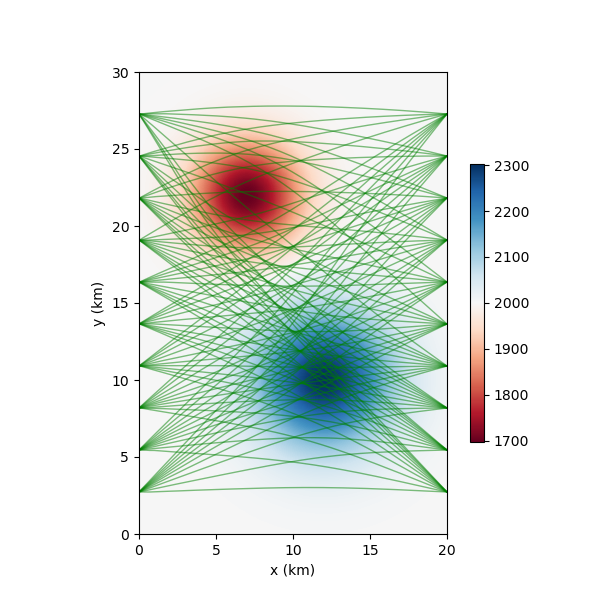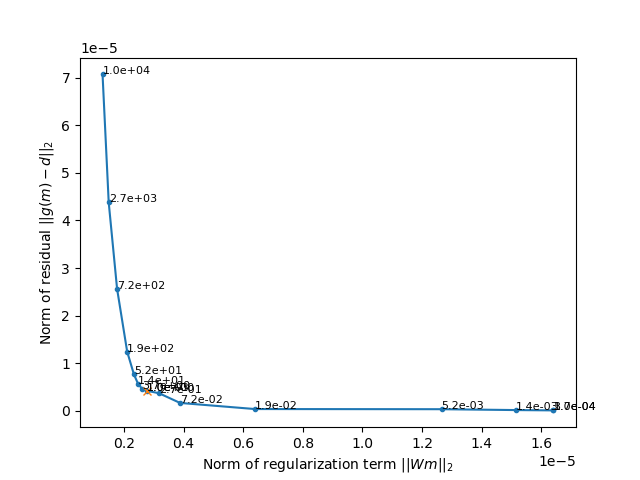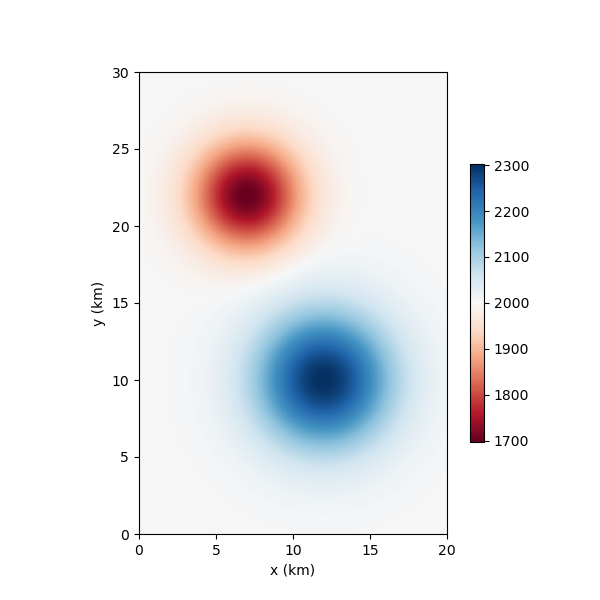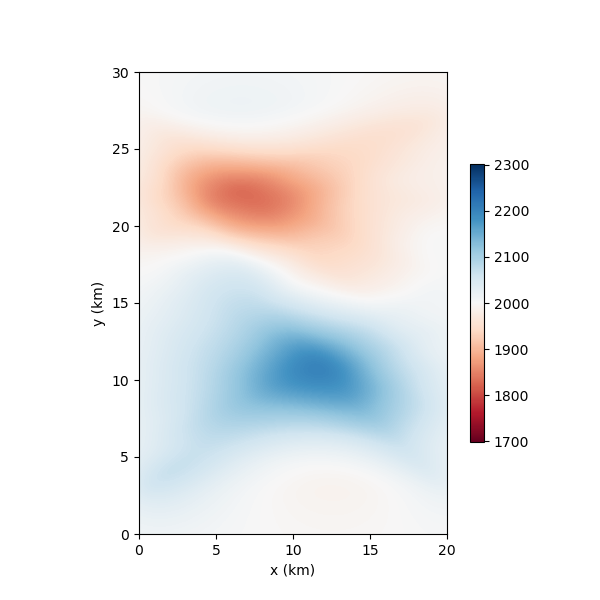Note
Go to the end to download the full example code
Seismic Wave Tomography via Fast Marching - Demo on switching regularization and L-curve#
If you are running this notebook locally, make sure you’ve followed steps here to set up the environment. (This environment.yml file specifies a list of packages required to run the notebooks)
In this notebook, we would like to demonstrate the capability of CoFI to easily switch between different types of regularizations.
We will use cofi to run a seismic wave tomography example, in which
the forward calculation is based on the Fast Marching Fortran code by
Nick Rawlinson. The Fast Marching code is wrapped in package
espresso.
We refer you to fmm_tomography.ipynb for further theretical details.
0. Import modules#
# -------------------------------------------------------- #
# #
# Uncomment below to set up environment on "colab" #
# #
# -------------------------------------------------------- #
# !pip install -U cofi geo-espresso
import numpy as np
import matplotlib.pyplot as plt
import pprint
import cofi
import espresso
Understanding the inference problem#
Before we starting working with cofi, let’s get familiar with the
problem itself.
Below is a plot of the true model and the paths generated from this model. As you can see, there are two anomalies, one with lower velocity (red, top left) and the other with higher velocity (blue, bottom right).
fmm = espresso.FmmTomography()
fmm.plot_model(fmm.good_model, with_paths=True);

New data set has:
10 receivers
10 sources
100 travel times
Range of travel times: 0.008911182496368759 0.0153757024856463
Mean travel time: 0.01085811731230709
<Axes: xlabel='x (km)', ylabel='y (km)'>
pprint.pprint(fmm.metadata)
{'author_names': ['Nick Rawlinson', 'Malcolm Sambridge'],
'citations': [('Rawlinson, N., de Kool, M. and Sambridge, M., 2006. Seismic '
'wavefront tracking in 3-D heterogeneous media: applications '
'with multiple data classes, Explor. Geophys., 37, 322-330.',
''),
('Rawlinson, N. and Urvoy, M., 2006. Simultaneous inversion of '
'active and passive source datasets for 3-D seismic structure '
'with application to Tasmania, Geophys. Res. Lett., 33 L24313',
'10.1029/2006GL028105'),
('de Kool, M., Rawlinson, N. and Sambridge, M. 2006. A '
'practical grid based method for tracking multiple refraction '
'and reflection phases in 3D heterogeneous media, Geophys. J. '
'Int., 167, 253-270',
''),
('Saygin, E. 2007. Seismic receiver and noise correlation based '
'studies in Australia, PhD thesis, Australian National '
'University.',
'10.25911/5d7a2d1296f96')],
'contact_email': 'Malcolm.Sambridge@anu.edu.au',
'contact_name': 'Malcolm Sambridge',
'linked_sites': [('Software published on iEarth',
'http://iearth.edu.au/codes/FMTOMO/')],
'problem_short_description': 'The wave front tracker routines solves boundary '
'value ray tracing problems into 2D '
'heterogeneous wavespeed media, defined by '
'continuously varying velocity model calculated '
'by 2D cubic B-splines.',
'problem_title': 'Fast Marching Wave Front Tracking'}
1. Problem setup and utilities#
# get problem information from espresso FmmTomography
model_size = fmm.model_size # number of model parameters
model_shape = fmm.model_shape # 2D spatial grids
data_size = fmm.data_size # number of data points
ref_start_slowness = fmm.starting_model
def objective_func(slowness, reg):
ttimes = fmm.forward(slowness)
residual = fmm.data - ttimes
data_misfit = residual.T @ residual
model_reg = reg(slowness)
return data_misfit + model_reg
def gradient(slowness, reg):
ttimes, A = fmm.forward(slowness, return_jacobian=True)
data_misfit_grad = -2 * A.T @ (fmm.data - ttimes)
model_reg_grad = reg.gradient(slowness)
return data_misfit_grad + model_reg_grad
def hessian(slowness, reg):
A = fmm.jacobian(slowness)
data_misfit_hess = 2 * A.T @ A
model_reg_hess = reg.hessian(slowness)
return data_misfit_hess + model_reg_hess
2. Invert with quadratic smoothing and damping regularization terms#
2.1 Define BaseProblem#
# define CoFI BaseProblem
fmm_problem_quadratic_reg = cofi.BaseProblem()
fmm_problem_quadratic_reg.set_initial_model(ref_start_slowness)
# add regularization: flattening + smoothing
smoothing_factor = 0.001
reg_smoothing = smoothing_factor * cofi.utils.QuadraticReg(
model_shape=model_shape,
weighting_matrix="smoothing"
)
fmm_problem_quadratic_reg.set_objective(objective_func, args=[reg_smoothing])
fmm_problem_quadratic_reg.set_gradient(gradient, args=[reg_smoothing])
fmm_problem_quadratic_reg.set_hessian(hessian, args=[reg_smoothing])
2.2 Define InversionOptions#
my_options = cofi.InversionOptions()
my_options.set_tool("cofi.simple_newton")
my_options.set_params(
num_iterations=15,
step_length=1,
obj_tol=1e-16,
verbose=True,
hessian_is_symmetric=True
)
2.3 Start an inversion#
inv = cofi.Inversion(fmm_problem_quadratic_reg, my_options)
inv_result_quadratic_reg = inv.run()
inv_result_quadratic_reg.summary()
Iteration #0, updated objective function value: 1.7333503598417198e-07
Iteration #1, updated objective function value: 2.4531149751843008e-09
Iteration #2, updated objective function value: 1.666821376148691e-10
Iteration #3, updated objective function value: 3.40997782806854e-11
Iteration #4, updated objective function value: 3.8205147744763477e-11
Iteration #5, updated objective function value: 1.9124945329717177e-11
Iteration #6, updated objective function value: 3.215129076867847e-11
Iteration #7, updated objective function value: 1.603032618496361e-11
Iteration #8, updated objective function value: 2.891380116342641e-11
Iteration #9, updated objective function value: 1.506331785126499e-11
Iteration #10, updated objective function value: 2.7052434154813148e-11
Iteration #11, updated objective function value: 1.4201001080880201e-11
Iteration #12, updated objective function value: 2.6062305943114613e-11
Iteration #13, updated objective function value: 1.3931639754656179e-11
Iteration #14, updated objective function value: 2.5358538408239953e-11
============================
Summary for inversion result
============================
SUCCESS
----------------------------
model: [0.00050485 0.00049715 0.00048991 ... 0.00050558 0.00050198 0.00049801]
num_iterations: 14
objective_val: 2.5358538408239953e-11
n_obj_evaluations: 16
n_grad_evaluations: 15
n_hess_evaluations: 15
2.4 Plotting#
clim = (1/np.max(fmm.good_model)-1, 1/np.min(fmm.good_model)+1)
fmm.plot_model(inv_result_quadratic_reg.model, clim=clim); # inverted model
fmm.plot_model(fmm.good_model); # true model
<Axes: xlabel='x (km)', ylabel='y (km)'>
3. Invert with Gaussian prior as regularization term#
Instead of using a smoothing and damping regularization, in this section, we use a model covariance matrix and prior model.
\(\chi_{P}^{2}=\left(\mathbf{y} -\mathbf{f}(\mathbf{m})\right)^T C_d^{-1} \left(\mathbf{y} -\mathbf{f}(\mathbf{m})\right) + \left( \mathbf{m} - \mathbf{m}_p \right)^T C_p^{-1} \left( \mathbf{m} - \mathbf{m}_p \right)\)
\(\Delta \mathbf{m}= ({J}^T {C}_d^{-1} {J}+{C}_p^{-1})^{-1} ({J}^T{C}_d^{-1} (\mathbf{y}-\mathbf{f}(\mathbf{m}))+{C}_p^{-1}(\mathbf{m}_p-\mathbf{m}))\)
We can use CoFI’s utility module to help us generate a the Gaussian prior term.
3.1 Define BaseProblem#
# define CoFI BaseProblem
fmm_problem_gaussian_prior = cofi.BaseProblem()
fmm_problem_gaussian_prior.set_initial_model(ref_start_slowness)
# add regularization: Gaussian prior
corrx = 3.0
corry = 3.0
sigma_slowness = 0.5**2
gaussian_prior = cofi.utils.GaussianPrior(
model_covariance_inv=((corrx, corry), sigma_slowness),
mean_model=ref_start_slowness.reshape(model_shape)
)
fmm_problem_gaussian_prior.set_objective(objective_func, args=[gaussian_prior])
fmm_problem_gaussian_prior.set_gradient(gradient, args=[gaussian_prior])
fmm_problem_gaussian_prior.set_hessian(hessian, args=[gaussian_prior])
3.2 Start an inversion#
# reuse the previously defined InversionOptions object
inv = cofi.Inversion(fmm_problem_gaussian_prior, my_options)
inv_result_gaussian_prior = inv.run()
inv_result_gaussian_prior.summary()
Iteration #0, updated objective function value: 3.633219726912795e-07
Iteration #1, updated objective function value: 2.350718903302729e-07
Iteration #2, updated objective function value: 2.3157837862886104e-07
Iteration #3, updated objective function value: 2.3147517910024575e-07
Iteration #4, updated objective function value: 2.3140410377459331e-07
Change in model parameters below tolerance, stopping.
============================
Summary for inversion result
============================
SUCCESS
----------------------------
model: [0.00049703 0.00049595 0.00049451 ... 0.000503 0.00050221 0.00050161]
num_iterations: 4
objective_val: 2.3140410377459331e-07
n_obj_evaluations: 6
n_grad_evaluations: 5
n_hess_evaluations: 5
3.3 Plotting#
fmm.plot_model(inv_result_gaussian_prior.model, clim=clim); # gaussian prior
fmm.plot_model(fmm.good_model); # true model
<Axes: xlabel='x (km)', ylabel='y (km)'>
4. L-curve#
Now we plot an L-curve for the smoothing regularization case.
lambdas = np.logspace(-4, 4, 15)
my_lcurve_problems = []
for lamb in lambdas:
my_reg = lamb * reg_smoothing
my_problem = cofi.BaseProblem()
my_problem.set_objective(objective_func, args=[my_reg])
my_problem.set_gradient(gradient, args=[my_reg])
my_problem.set_hessian(hessian, args=[my_reg])
my_problem.set_initial_model(ref_start_slowness)
my_lcurve_problems.append(my_problem)
my_options.set_params(verbose=False)
def my_callback(inv_result, i):
m = inv_result.model
res_norm = np.linalg.norm(fmm.forward(m) - fmm.data)
reg_norm = np.sqrt(reg_smoothing(m))
print(f"Finished inversion with lambda={lambdas[i]}: {res_norm}, {reg_norm}")
return res_norm, reg_norm
my_inversion_pool = cofi.utils.InversionPool(
my_lcurve_problems,
my_options,
my_callback,
True
)
all_res, all_cb_returns = my_inversion_pool.run()
l_curve_points = list(zip(*all_cb_returns))
# plot the L-curve
res_norm, reg_norm = l_curve_points
plt.plot(reg_norm, res_norm, '.-')
plt.xlabel(r'Norm of regularization term $||Wm||_2$')
plt.ylabel(r'Norm of residual $||g(m)-d||_2$')
for i in range(len(lambdas)):
plt.annotate(f'{lambdas[i]:.1e}', (reg_norm[i], res_norm[i]), fontsize=8)
# plot the previously solved model
my_inverted_model = inv_result_quadratic_reg.model
my_reg_norm = np.sqrt(reg_smoothing(my_inverted_model))
my_residual_norm = np.linalg.norm(fmm.forward(my_inverted_model) - fmm.data)
plt.plot(my_reg_norm, my_residual_norm, "x")
plt.annotate(f"{smoothing_factor:.1e}", (my_reg_norm, my_residual_norm), fontsize=8);

Text(2.7726666314754742e-06, 4.203671985174676e-06, '1.0e-03')
Watermark#
watermark_list = ["cofi", "espresso", "numpy", "matplotlib"]
for pkg in watermark_list:
pkg_var = __import__(pkg)
print(pkg, getattr(pkg_var, "__version__"))
cofi 0.2.7
espresso 0.3.13
numpy 1.24.4
matplotlib 3.8.3
sphinx_gallery_thumbnail_number = -1
Total running time of the script: (8 minutes 8.673 seconds)





